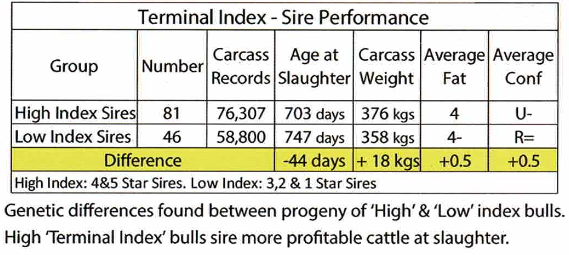The Irish Grassland Association Beef Conference and Farm Walk – which was sponsored by MSD Animal Health and Mullinahone Co-op – took place on Thursday, May 24.
On the day, the Irish Cattle Breeding Federation’s (ICBF’s) Chris Daly highlighted the difference in the progeny of high terminal index sires (4 and 5-star) and low terminal index sires (1, 2 and 3-star).
The study involved 81 high-index sires and 46 low-index sires. Through the ICBF’s database, the progeny records for all of the bulls involved were accessed.
Firstly, there were 44 days in the difference at age of slaughter; it took the progeny from the low-index sires 44 days longer to finish than progeny from the high-index sires.
This has a major impact on feeding costs. Teagasc’s Christy Watson outlined that the feeding costs associated with an intensive-feeding system are in the region of €2.50-3.00/day.
So therefore, if we take feeding costs at €3.00/day, it costs – based on these figures – an extra €132 to finish progeny from the low terminal index sires compared to the high-index sires.
Moving to carcass weights, the progeny from the high terminal index sires were 18kg heavier at slaughter.
If we take a price of 400c/kg, farmers are looking at €72 in the difference of progeny from high terminal index sires versus low-index sires.
Adding that to the €132 saved from the faster finish, that’s over €200 in the difference between the progeny from high terminal index sires versus low terminal index sires.
There was little difference recorded on fat covers. However, the progeny from high-index sires averaged U- grades, while the low-index sires’ progeny averaged R= grades; if these animals are being killed on the grid, there is another 12c/kg in it for the farmer.
Data interpretation
Chris also explained the importance of choosing sires that will best suit the system on each individual farm.
“Data interpretation is key; there are two indexes in beef – replacement index and terminal index. If they are used in the wrong places, they are going to do a lot of damage and they are not going to benefit your system.
“Farmers have to interpret the information properly. Maybe the star system has – in a way – been a victim of its own success; some farmers have tried to over simplify it.
“For example, some farmers have gone out and bought a 5-star bull; but 5-stars on what? Is it on the replacement index or on the terminal index? Is he 5-stars for carcass or is he 5-stars for milk? Is it within breed or is it across breed?” he questioned.
“Farmers have to interpret the figures more; you have to ask yourself: What am I trying to produce and you have to use the indexes correctly when trying to produce those animals,” he concluded.


